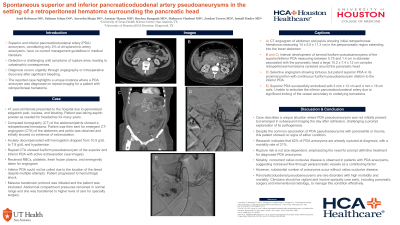Sunday Poster Session
Category: Biliary/Pancreas
P0081 - Spontaneous superior and inferior pancreaticoduodenal artery pseudoaneurysms in the setting of a retroperitoneal hematoma surrounding the pancreatic head
Sunday, October 27, 2024
3:30 PM - 7:00 PM ET
Location: Exhibit Hall E

Has Audio

Asad Rehman, DO
HCA Kingwood
San Antonio, TX
Presenting Author(s)
Asad Rehman, DO1, Salman Islam, DO2, Aneesha Shaju, DO2, Ammar Hasan, MD1, Bushra Bangash, MD1, Mahnoor Hashmi, MD1, Jordan Torres, MD2, Ismail Hader, MD1
1HCA Kingwood, Kingwood, TX; 2HCA Healthcare, Kingwood, TX
Introduction: Superior and inferior pancreaticoduodenal artery (PDA) aneurysms are rare and have no current management guidelines. They constitute only 2% of all splanchnic artery aneurysms. Detection is challenging until symptoms of potentially fatal rupture arise. Diagnosis occurs urgently through angiography or intraoperatively after bleeding. In this case, the PDA aneurysm was diagnosed before rupture and successfully surgically resected.
Case Description/Methods: A 47-year-old female with a past medical history of hypertension and mitral valve prolapse presented to the hospital due to generalized epigastric pain, nausea, and bloating. She had been taking aspirin powder daily for pain. Computed tomography (CT) of the abdomen and pelvis showed a retroperitoneal hematoma. She was sent for an emergent CT angiogram (CTA), which showed no evidence of extravasation. The patient became hypotensive with hemoglobin dropping from 10.9 to 7.8 g/dL, warranting repeat CTA, which showed a fusiform pseudoaneurysm of the superior and inferior PDAs with active extravasation. The inferior PDA could not be coiled during the emergent angiogram due to the location of the bleed. After multiple attempts, the patient progressed to hemorrhagic shock. Massive transfusion protocol was initiated, and the patient was intubated. Abdominal compartment pressures remained normal, and she was transferred to higher care for specialty surgery.
Discussion: The rapid emergence of the PDA pseudoaneurysm in this patient poses a challenge in explaining its pathogenesis within a brief timeframe. This patient showed no signs of pancreatitis or abdominal trauma. The significance of these aneurysms lies in their potential for rupture and the associated mortality. Twice as many PDA aneurysms rupture compared to gastroduodenal artery (GDA) aneurysms at presentation. 35% of GDA aneurysms and 62% of PDA aneurysms are already ruptured at diagnosis, with a mortality rate of 21%. Rupture risk is not size-dependent, and prompt definitive treatment is recommended. A notable incidence of concurrent celiac occlusive disease has been noted in patients with PDA aneurysms, due to increased peripancreatic vessel flow. However, a substantial number of aneurysms occur without celiac occlusive disease. Studies are limited and often do not differentiate pseudo from true aneurysms, making it hard to draw reliable conclusions. Early recognition by clinicians and prompt involvement of specialized surgical and radiology teams are crucial for patient survival.

Disclosures:
Asad Rehman, DO1, Salman Islam, DO2, Aneesha Shaju, DO2, Ammar Hasan, MD1, Bushra Bangash, MD1, Mahnoor Hashmi, MD1, Jordan Torres, MD2, Ismail Hader, MD1. P0081 - Spontaneous superior and inferior pancreaticoduodenal artery pseudoaneurysms in the setting of a retroperitoneal hematoma surrounding the pancreatic head, ACG 2024 Annual Scientific Meeting Abstracts. Philadelphia, PA: American College of Gastroenterology.
1HCA Kingwood, Kingwood, TX; 2HCA Healthcare, Kingwood, TX
Introduction: Superior and inferior pancreaticoduodenal artery (PDA) aneurysms are rare and have no current management guidelines. They constitute only 2% of all splanchnic artery aneurysms. Detection is challenging until symptoms of potentially fatal rupture arise. Diagnosis occurs urgently through angiography or intraoperatively after bleeding. In this case, the PDA aneurysm was diagnosed before rupture and successfully surgically resected.
Case Description/Methods: A 47-year-old female with a past medical history of hypertension and mitral valve prolapse presented to the hospital due to generalized epigastric pain, nausea, and bloating. She had been taking aspirin powder daily for pain. Computed tomography (CT) of the abdomen and pelvis showed a retroperitoneal hematoma. She was sent for an emergent CT angiogram (CTA), which showed no evidence of extravasation. The patient became hypotensive with hemoglobin dropping from 10.9 to 7.8 g/dL, warranting repeat CTA, which showed a fusiform pseudoaneurysm of the superior and inferior PDAs with active extravasation. The inferior PDA could not be coiled during the emergent angiogram due to the location of the bleed. After multiple attempts, the patient progressed to hemorrhagic shock. Massive transfusion protocol was initiated, and the patient was intubated. Abdominal compartment pressures remained normal, and she was transferred to higher care for specialty surgery.
Discussion: The rapid emergence of the PDA pseudoaneurysm in this patient poses a challenge in explaining its pathogenesis within a brief timeframe. This patient showed no signs of pancreatitis or abdominal trauma. The significance of these aneurysms lies in their potential for rupture and the associated mortality. Twice as many PDA aneurysms rupture compared to gastroduodenal artery (GDA) aneurysms at presentation. 35% of GDA aneurysms and 62% of PDA aneurysms are already ruptured at diagnosis, with a mortality rate of 21%. Rupture risk is not size-dependent, and prompt definitive treatment is recommended. A notable incidence of concurrent celiac occlusive disease has been noted in patients with PDA aneurysms, due to increased peripancreatic vessel flow. However, a substantial number of aneurysms occur without celiac occlusive disease. Studies are limited and often do not differentiate pseudo from true aneurysms, making it hard to draw reliable conclusions. Early recognition by clinicians and prompt involvement of specialized surgical and radiology teams are crucial for patient survival.

Figure: A) CT angiogram of abdomen and pelvis showing initial retroperitoneal hematoma measuring 14 x 5.5 x 11.3 cm in the peripancreatic region extending into the lower abdomen.
B) Interval development of several fusiform pseudoaneurysms of the superior/inferior PDA measuring between 0.75 and 1.4 cm in diameter associated with the pancreatic head and a 10.2 x 7.4 x 12 cm complex retroperitoneal hematoma centered around the pancreatic head.
C) Selective angiogram showing tortuous but patent superior PDA in its proximal portion with continuous fusiform pseudoaneurysm dilation to the inferior PDA.
D) Superior PDA successfully embolized with 3 mm x 12 cm and 4 mm x 16 cm coils. Unable to embolize the inferior PDA due to significant kinking of the vessel secondary to underlying hematoma.
B) Interval development of several fusiform pseudoaneurysms of the superior/inferior PDA measuring between 0.75 and 1.4 cm in diameter associated with the pancreatic head and a 10.2 x 7.4 x 12 cm complex retroperitoneal hematoma centered around the pancreatic head.
C) Selective angiogram showing tortuous but patent superior PDA in its proximal portion with continuous fusiform pseudoaneurysm dilation to the inferior PDA.
D) Superior PDA successfully embolized with 3 mm x 12 cm and 4 mm x 16 cm coils. Unable to embolize the inferior PDA due to significant kinking of the vessel secondary to underlying hematoma.
Disclosures:
Asad Rehman indicated no relevant financial relationships.
Salman Islam indicated no relevant financial relationships.
Aneesha Shaju indicated no relevant financial relationships.
Ammar Hasan indicated no relevant financial relationships.
Bushra Bangash indicated no relevant financial relationships.
Mahnoor Hashmi indicated no relevant financial relationships.
Jordan Torres indicated no relevant financial relationships.
Ismail Hader indicated no relevant financial relationships.
Asad Rehman, DO1, Salman Islam, DO2, Aneesha Shaju, DO2, Ammar Hasan, MD1, Bushra Bangash, MD1, Mahnoor Hashmi, MD1, Jordan Torres, MD2, Ismail Hader, MD1. P0081 - Spontaneous superior and inferior pancreaticoduodenal artery pseudoaneurysms in the setting of a retroperitoneal hematoma surrounding the pancreatic head, ACG 2024 Annual Scientific Meeting Abstracts. Philadelphia, PA: American College of Gastroenterology.
